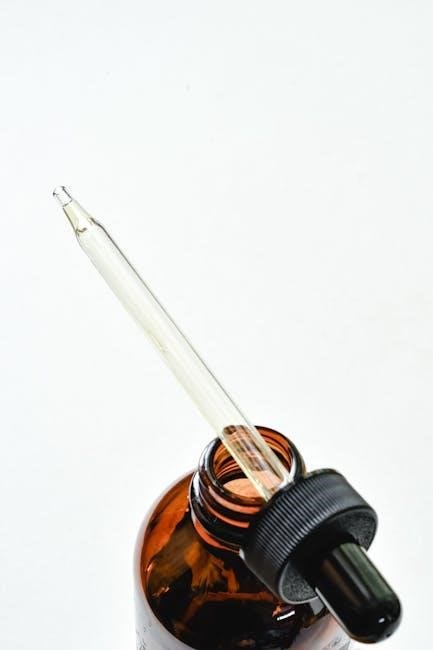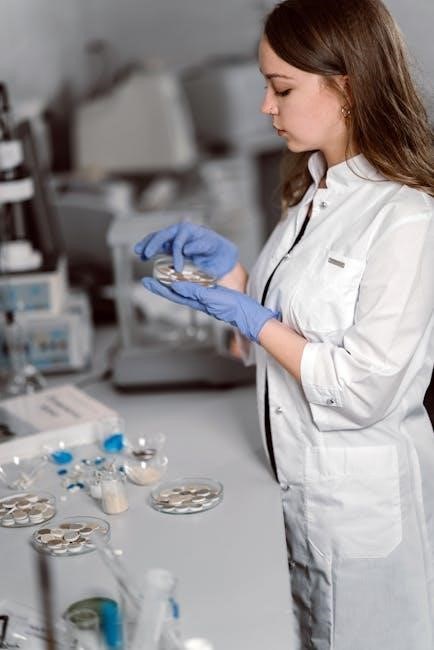The manual introduces students to hands-on chemistry, serving as an essential guide for experiments. It covers fundamental concepts, practical applications, and safe laboratory practices, fostering a comprehensive understanding of chemical principles.
1.1 Importance of Laboratory Manuals in Chemistry Education
Laboratory manuals are crucial for chemistry education, providing structured guidance for experiments and fostering practical understanding. They outline safety protocols, experimental procedures, and data analysis methods, ensuring students grasp fundamental concepts. Manuals also promote critical thinking and problem-solving skills, preparing learners for real-world scientific challenges. By offering clear instructions and expected outcomes, they enhance learning efficiency and reduce errors. Additionally, they serve as invaluable resources for reviewing techniques and theories, making them indispensable tools for both students and educators in chemistry laboratories.

Safety Guidelines and Laboratory Rules
Adhering to safety guidelines is critical in chemistry labs. Wear protective gear, follow protocols, and handle chemicals cautiously to minimize risks and ensure a secure environment.
2.1 Essential Safety Protocols for Chemistry Labs
Essential safety protocols in chemistry labs include wearing lab coats, gloves, and goggles to protect against chemical exposure. Students must read Material Safety Data Sheets (MSDS) before handling chemicals. Proper ventilation is crucial to prevent inhalation of harmful fumes. Equipment should be inspected for damage, and unauthorized experiments are strictly prohibited. Familiarity with emergency exits, fire extinguishers, and spill procedures is mandatory. Additionally, avoiding eating or drinking in the lab and keeping long hair tied back are vital safety measures to ensure a secure working environment for all students and staff.

Basic Laboratory Techniques
Mastering fundamental skills like measuring, mixing, and heating substances is crucial. Techniques include using glassware, balances, and Bunsen burners safely and accurately to ensure precise experimental outcomes.
3.1 Fundamental Skills for Conducting Chemistry Experiments
Fundamental skills are essential for conducting chemistry experiments effectively. These include precise measurement techniques, proper use of laboratory equipment, and safe handling of chemicals. Students learn to accurately measure volumes and masses, ensuring data reliability; Understanding glassware, such as burettes and pipettes, is crucial for titrations and other procedures. Additionally, mastering heating methods and observing reactions are key. These skills form the foundation for more complex experiments, emphasizing the importance of practice and attention to detail to achieve accurate and reproducible results in a chemistry laboratory setting.

Common Laboratory Equipment and Their Uses
Essential lab equipment includes burettes, pipettes, beakers, and Bunsen burners. These tools are used for precise measurements, mixing, heating, and observing chemical reactions, ensuring accurate experimental outcomes.
4.1 Identifying and Utilizing Essential Chemistry Lab Equipment
Identifying and utilizing essential chemistry lab equipment is crucial for conducting experiments safely and effectively. Common tools include burettes for precise liquid measurements, pipettes for transferring small volumes, and beakers for mixing solutions. Bunsen burners provide controlled heat sources, while test tubes and flasks are used for reactions. Understanding each tool’s purpose and proper handling ensures accurate results and minimizes risks. Familiarity with equipment like balance scales for weighing substances and thermometers for temperature monitoring is also vital. Proper utilization of these tools enhances experimental efficiency and safety in the chemistry laboratory setting.

Experimental Procedures and Data Analysis
Properly following experimental procedures ensures accurate and reliable results. Detailed step-by-step guides help students execute tasks systematically. Data analysis involves interpreting observations, calculating values, and drawing conclusions, fostering critical thinking and scientific understanding.
5.1 Step-by-Step Guides for Conducting Chemistry Experiments
Step-by-step guides are crucial for ensuring experiments are conducted safely and effectively. They outline materials, procedures, and expected outcomes, helping students follow structured protocols. Each guide begins with an objective, listing required chemicals and equipment. Detailed instructions often include safety precautions, measurement techniques, and observation recording. Visual aids like diagrams and videos enhance understanding. Students learn to perform tasks systematically, from preparing solutions to analyzing data. These guides also emphasize accurate record-keeping and proper waste disposal, fostering a culture of precision and responsibility in laboratory practices. This systematic approach helps students master experimental techniques and interpret results confidently.

Environmental and Safety Considerations
Proper handling and disposal of chemical waste are emphasized to minimize environmental impact. Safety protocols ensure a secure lab environment, protecting both students and the planet from harmful exposures.
6.1 Proper Handling and Disposal of Chemical Waste
Proper handling and disposal of chemical waste are critical to preventing environmental contamination and ensuring lab safety. All waste must be segregated into appropriate categories, such as flammable, corrosive, or toxic materials. Containers for waste disposal should be clearly labeled and stored in designated areas. Material Safety Data Sheets (MSDS) provide essential information for safe disposal. Trained personnel should oversee the process to comply with local and environmental regulations. Improper disposal can lead to severe ecological damage, making adherence to guidelines paramount for sustainability and safety in chemistry laboratories.

Resources for Advanced Learning
Advanced learning resources include online lab manuals, eTextbooks, and interactive tools. These materials provide detailed experiment guides, video tutorials, and access to updated chemical data for enhanced understanding and practical skills.
7.1 Recommended Lab Manuals and Online Tools for Chemistry Students
For advanced learning, recommended lab manuals include the General Chemistry I Honors Laboratory Manual and the Online Chemistry Lab Manual by Santa Monica College. These resources provide detailed experiment guides, safety protocols, and interactive tools. Additionally, video tutorials on platforms like YouTube offer practical demonstrations of lab techniques. Online forums and educational websites, such as those offering NCERT lab manuals, further enhance understanding. These tools ensure students have access to comprehensive materials, fostering both theoretical knowledge and hands-on skills in chemistry. They are essential for supplementing classroom learning and preparing for advanced experiments.

Best Practices for Maintaining a Lab Notebook
Record observations accurately, ensuring clarity and organization. Document materials, procedures, and results thoroughly. Use proper formatting and referencing for consistency. Maintain legibility and avoid erasures for professionalism.
8.1 Recording Observations and Results Accurately
Accurate recording is crucial for reproducibility. Note every measurement, observation, and calculation in detail. Use clear, concise language and avoid abbreviations. Include dates, experiment titles, and page numbers. Document unexpected results, as they may indicate trends. Use tables and graphs to present data visually. Review and initial entries for accountability. Never erase mistakes; instead, strike through them and correct. Maintain consistency in units and formatting. Ensure all results are traceable and verifiable, adhering to scientific standards for precision and reliability in future analyses or presentations.

Troubleshooting Common Lab Errors
Identify and address errors promptly to ensure accurate results. Common mistakes include miscalculations, improper equipment use, and incorrect measurements. The manual provides solutions to these issues.
9.1 Identifying and Correcting Mistakes in Chemistry Experiments
Recognizing errors in chemistry experiments is crucial for accurate results. Common mistakes include miscalculations, improper equipment usage, and incorrect measurements. To address these, systematically review procedures, compare expected outcomes, and consult lab manuals. Documenting observations and rechecking calculations can help pinpoint issues. Corrective actions may involve repeating steps, recalibrating instruments, or adjusting reagent quantities. Understanding error sources improves experimental design and data reliability. Regular practice and adherence to safety protocols minimize mistakes, fostering a culture of precision and accountability in lab work. This ensures experiments yield valid, reproducible results, aligning with scientific standards and safety guidelines.

